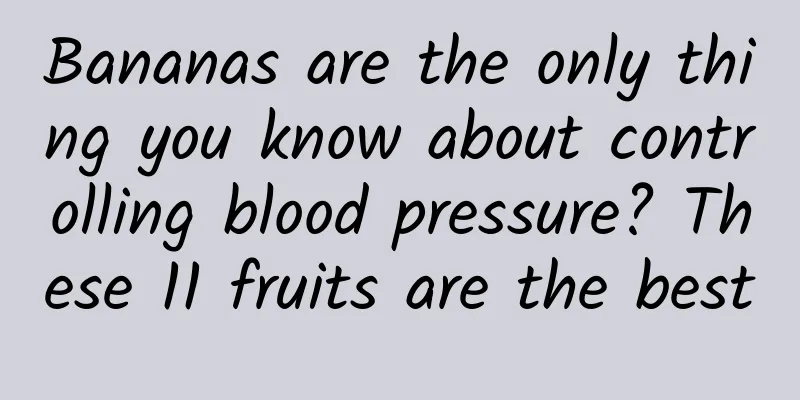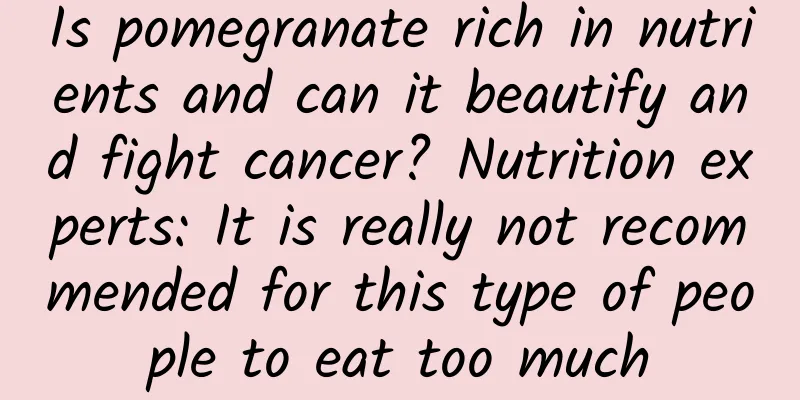Bananas are the only thing you know about controlling blood pressure? These 11 fruits are the best

|
There are so many people suffering from hypertension nowadays, from ignorant teenagers to elderly people. A healthy diet is crucial to controlling blood pressure. Potassium supplementation can lower blood pressure in both hypertensive and normal blood pressure patients. This mechanism of action may be related to the fact that potassium can promote urinary sodium excretion, affect the renin-angiotensin and sympathetic nervous system, and improve peripheral vascular resistance. [1] Therefore, eating more potassium-rich foods in the diet will help control blood pressure. The following fruits are especially recommended, as they have good potassium content and are also commonly found in supermarkets. 1. Fruits with higher potassium content than bananas Bananas are known as a "potassium supplement expert" in everyone's mind, but the five fruits mentioned below are even better than bananas in supplementing potassium. avocado Avocado, also known as alligator pear, has a potassium content of 599 mg/100 g, which is 2.3 times that of banana. This content is the leader in potassium content among fruits. You can eat it directly with a spoon, or make it into puree and spread it on bread, or use it to make vegetable and fruit salads. It is refreshing and stimulates appetite. However, many people are afraid to eat avocados because of their high fat content. In fact, 80% of the fat in avocados is unsaturated fatty acids, mainly monounsaturated fatty acids, mainly oleic acid, which is a kind of fat that is beneficial to health and helps reduce the risk of heart disease and stroke. Dried persimmon Persimmon cake is concentrated persimmon made from peeled, sun-dried, sulfur-fumigated, shaped, piled and dried. It has a high potassium content of 339 mg/100 g, which is 1.3 times that of bananas. Dried persimmons are also rich in beta-carotene, which can be converted into vitamin A in the body and is good for the health of the eyes and skin. You don't have to worry about tannic acid when eating dried persimmons, because the tannic acid content will be greatly reduced during the processing of dried persimmons. As for the white frost on the outside of the persimmon cake, it is not some dirt, but sugar that is precipitated during the production process, including mannitol, glucose and fructose. When processing dried persimmons, they must be covered with frost, also known as stacking. Place the dried persimmons in a sealed ceramic jar, with a layer of dried persimmon skin on top. When the jar is full, cover it with a layer of persimmon skin and seal it. Place it in a cool and dry place for 5 to 7 days, observing it every day. It will take about 30 days for a layer of white frost powder to form on the surface of the dried persimmons. [2] jackfruit Jackfruit is a fruit with a unique taste. Its potassium content is 330 mg/100 g, which is 1.3 times the potassium content of the bananas we often eat. It is also rich in polysaccharides and carotene. When eating jackfruit, it is recommended not to throw away the core, which is also high in potassium. Boil it in salt water, or remove the shell and put it in rice. It tastes chewy and has a chestnut flavor. It is worth a try. banana Plantains and bananas are relatives, but plantains have 1.3 times more potassium than bananas, at 330 mg/100 g. Plantains are short, thick and fat, while bananas are long and thin. Plantains also have a higher dietary fiber content than bananas, so when it comes to preventing constipation, it is more reliable to eat ripe plantains. durian Although durian smells "stinky", its potassium content is not low, 261 mg/100 g, which is higher than that of banana. Although the potassium content of the above five fruits is higher than that of bananas, their calories are also much higher than that of bananas. If you want to eat them, control it to about 100 grams a day. Eating more is not conducive to weight control. In addition, people with high blood pressure and high blood sugar should not eat too much dried persimmons, jackfruits, plantains, and durian. But it doesn't matter, you can take a look at the following 6 kinds of fruits. Although their potassium content per 100 grams is not as high as that of bananas, they are low in calories, so eating more is not a burden, and you can also take in more potassium. 2. Fruits with moderate potassium content but low calories Yellow Marshal Apple There are many varieties of apples. The characteristic of Huang Yuanshuai is its "soft taste", which is very suitable for the elderly and children with bad teeth. Its potassium content is 184 mg/100 g, which is less than 72% of the potassium content of bananas, but the calories are much lower than bananas. Bananas have 93 kcal/100 g of calories, while Huang Yuanshuai apples have only 59 kcal/100 g. Eating 150 grams of Huang Yuanshuai will take in about the same amount of calories as eating 100 grams of bananas, but it will take in more potassium than bananas. Apple Pear Apple pear looks like both an apple and a pear, and has a crisp and sweet taste. It can also be made into frozen pears in winter, which is a special flavor. The potassium content is similar to that of Huang Yuanshuai apple, which is 180 mg/100 g, but the calories are lower than Huang Yuanshuai apple. Prunes Prunes look a lot like plums and are considered by many people to be a "shit-killer". They contain 155 mg of potassium per 100 g and only 45 kcal per 100 g. Eating 220 g of prunes provides about the same amount of calories as eating 100 g of bananas, but the potassium intake is nearly 1.4 times that of bananas. However, prunes contain sorbitol, which is found in many fruits. Due to its osmotic effect and its ability to promote gastrointestinal motility, prunes can easily cause diarrhea. Generally, eating about 5 grams at a time may cause abdominal discomfort, and eating more than 10 grams will cause diarrhea. [3] The sorbitol content of fresh prunes can reach 2.6 grams per 100 grams. In order to avoid diarrhea, it is best not to eat more than 250 grams of prunes at a time. Cantaloupe Muskmelon, also known as cantaloupe, is sweet and is one of the most popular fruits in summer. It has a potassium content of 139 mg/100 g and a very low calorie content of only 26 kcal/100 g. This means that if you eat nearly 360 g of cantaloupe, the calories you consume are about the same as those of 100 g of bananas, while the potassium content is nearly twice that of 100 g of bananas. For those who like to eat fruits but need to lose weight and control blood pressure, this really does not require any psychological burden. strawberry Strawberries are really popular with many people. They can't stop eating them! They have a good potassium content, about the same as cantaloupe, at 131 mg/100 g. They are also low in calories, at only 32 kcal/100 g. They are also rich in vitamin C. Eating seven or eight large strawberries can meet your daily vitamin C needs. Grape The potassium content of grapes is 127 mg/100 g, and the calories are only 45 kcal/100 g. The calories consumed by eating 200 grams of grapes are lower than those of 100 grams of bananas, but the potassium content is similar to that of bananas. Although it tastes sweet, it is a low GI and low GL fruit. Even diabetics can eat it with confidence as long as the amount is controlled within 200 grams. Compared with the 5 high potassium fruits mentioned in the first half, the 6 fruits in the second half are slightly inferior in potassium content, but they are low in calories and you can eat more of them. They can help control your weight and supplement potassium, which is really nice. Summarize: Fruits high in potassium include avocado, dried persimmon, jackfruit, banana and durian, but they should be eaten less due to their high calories; fruits with medium potassium content but low calories include yellow marshal apples, apple pears, prunes, cantaloupe, strawberries and grapes, and you can eat more of them, they are good for replenishing potassium! References: [1] Yang Yuexin, Ge Keyou. Chinese Nutrition Science Encyclopedia 2nd Edition (Volume 1)[M]. People's Medical Publishing House, 2019 [2] Li Xingguang, Zhang Shuili. Research on the home production process of persimmon cake [J]. Agricultural Products Processing: Part 2, 2006(4):65-66 [3]Hyams, JS (1983). Sorbitol intolerance: an unappreciated cause of functional gastrointestinal complaints. Gastroenterology, 84(1), 30-33. [4] Yang Yuexin. Chinese Food Composition Table 6th Edition Volume 1[M]. Peking University Medical Press, 2018 Author: Xue Qingxin, member of Chinese Nutrition Society, registered dietitian, health manager, public nutritionist Reviewer: Ruan Guangfeng, Deputy Director of Kexin Food and Health Information Exchange Center The pictures are from the copyright gallery. Use without permission may involve copyright risks. The article is produced by Science Popularization China - Creation and Cultivation Program. Please indicate the source when reprinting. |
<<: Autism is not a quirk: Breaking down misconceptions about ASD
Recommend
Now I know why I often feel dizzy!
Dizziness is a common thing in daily life. Someti...
In what cases should hysteroscopy be performed
Hysteroscopy is a method of examining and treatin...
Is freezing eggs painful?
Egg freezing is the technology of freezing eggs. ...
Should I use egg liquid or egg yolk when baking mooncakes? Why do mooncakes deform when baking?
As a traditional food of the Chinese nation, moon...
What are the differences between the three railway stations in Shanghai? Which one is the largest, Beijing or Shanghai?
After the liberation of Shanghai, finances were t...
Are you still playing with your phone before bed? Be careful!
After a busy day, I washed up and lay down on the...
Early pictures of breast cancer
Many women are not aware of the early symptoms of...
Eyes also need an annual checkup. Have you done it this year?
Talking about annual inspection Car owners are no...
Normal menstruation at 49 years old suddenly stopped
After reaching a certain age, women will experien...
What to eat after confinement
What is the best thing for women to eat during th...
What to do if the milk becomes less after getting angry
After giving birth, mothers have fewer opportunit...
How to take care of excessive eye use during confinement
Anyway, female friends always neglect their bodie...
Some reasons for progesterone values at 8 weeks of pregnancy
Today I was free and looked up some articles abou...
Why does the OPPO phone fast charge stop charging? How can I force the OPPO phone to start up?
Following up on the last issue where we shared so...
Symptoms of Yin deficiency and dryness and heat in women
Yin deficiency constitution is a common physical ...









